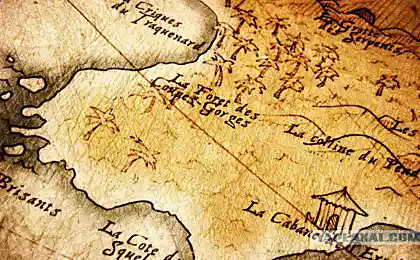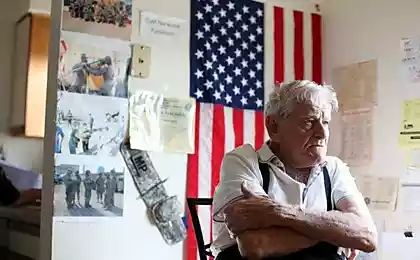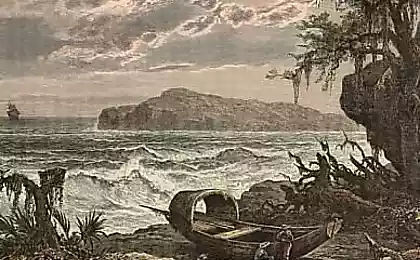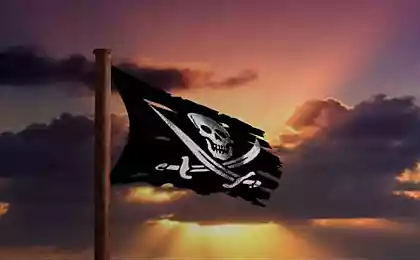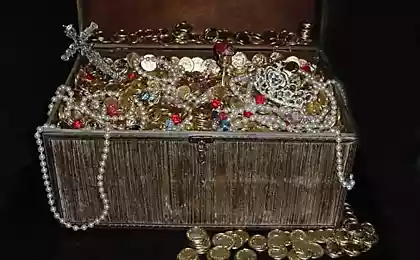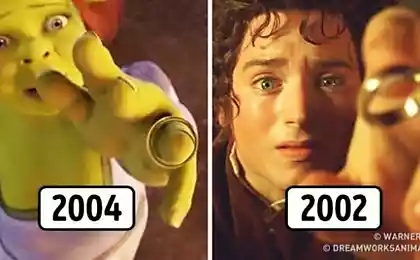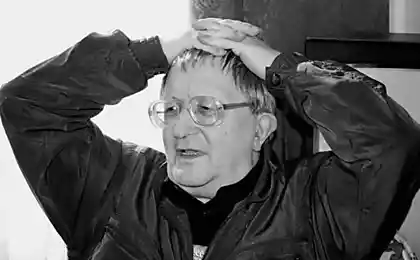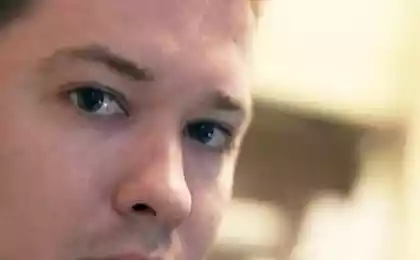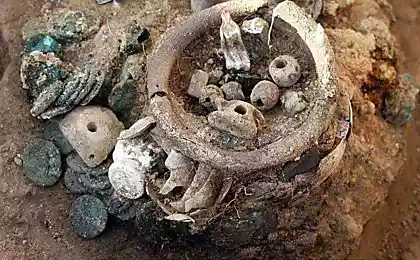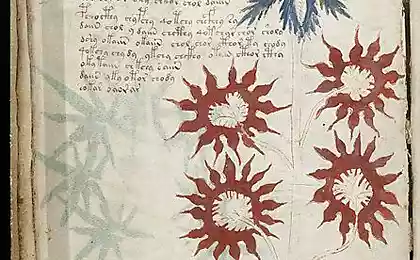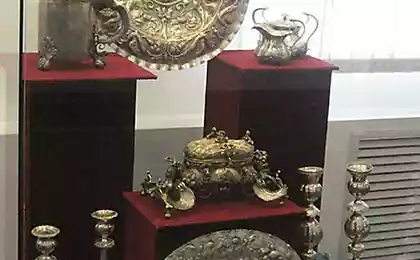1146
Pirate treasure (6 photos + text)
Pirates - people who constantly risk their lives, try not to think about the future, and therefore obtained in the battles of wealth easily swam out of their hands. Information about the treasures Ticha, Morgan Kidd and other pirate captains for centuries have acquired a network of legends that have been impossible to distinguish truth from fiction. There is no doubt that in many legends about them have some element of truth, but no accident that finds pirate treasure - an extremely rare phenomenon. Here I will mention only some of the stories of the legendary pirate treasure.
If the map of the Western Hemisphere by the City of Montreal to the southeast draw a straight line to the Cape of Cabo Frio, located at the eastern tip of South America, and then connect the line this cape to Cocos Island in the Pacific Ocean near Panama, and spend another line from Coco to Montreal, the triangle will appear on the map. Throughout the world, it is called the "Golden Triangle" or "Triangle of treasure." Whose treasure here looking for?
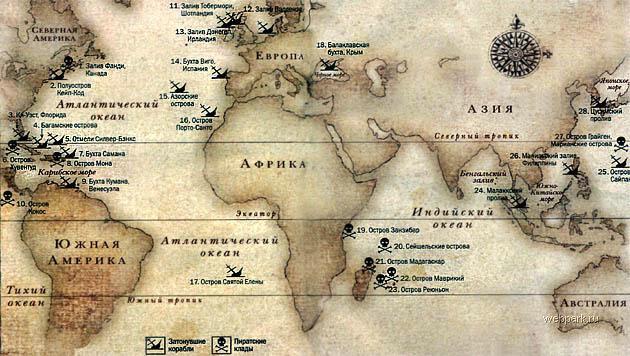
centuries in the southern seas were the battle for the gold of America and India. As a result of the treasures they settled not only in the execution of the king.
At the beginning of the XVI century from America to Europe flooded gold. Wealth Aztecs and Incas, filled the holds of Spanish galleons, in just one century increased the gold and silver reserve of European countries five times.
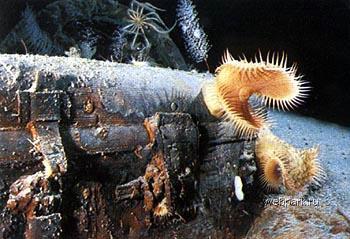
At first, ships bound for Spain, went across the Atlantic in small groups without an armed escort. But soon loomed on the horizon threatening competitors. Already in 1496, Christopher Columbus, returning from his second voyage, was attacked by French corsairs. However, the main threat to the Spanish fleet of galleons were English privateers - pirates in the service of the British Crown. Many of them, such as the famous navigator and pirate Francis Drake, was given the title of nobility - for deeds of his fatherland brought millions of pounds of gold. It was a "legitimate" part of the production is supplied to the royal treasury after successful privateers attacks on Spanish ships.
Drake became famous for his daring raids on Spanish ports in South America and in Spain itself. However, most of the privateers serve more cautious approach: they lay in wait for returns from America Spanish ships in the Caribbean or in the Azores.
Azores in the XVI century were the main transshipment point in the global trade routes. Wherever came the ships - from America, India or South Africa, their path lay through the abandoned in the vastness of the Atlantic island of Terceira, Pico and Jorge. There stocked with food and drinking water. Azores called "hotel, which the Lord has put in place a suitable ocean."
In the waters around this "hotel" buried dozens of ships. In 1594 a Portuguese ship "Chagas' returns from the Indian colonies. According to testimonies and archival documents, it was the price of the treasure in the then two million ducats - gold coins, each weighing 3, 5 grams. It was the most expensive load ever goes to Europe from India. Also on board were two sailors shipwrecked Portuguese schooners. Swimming turned out awful even by the standards of a cruel time: due to the excessive number of crew on board played out several epidemic diseases, but the worst was the scurvy. Hourly had to dump overboard dead. This "floating hospital" was an easy catch for the three English ships that ambushed near one of the Portuguese Azores. After a very brief exchange of fire in the gun gunpowder hold of the ship fire broke out and the ship sank in the Atlantic Ocean. Until now find his remains no one has. Also irretrievably sunk close to the Azores in 1591, the Spanish "Silver Fleet» (Silver Train) - ships have been a victim of the famous "Plotnitsky wind." This insidious southeast hurricane is so named because it often brings to the shore wooden wreckage wrecked ships.

According to historical sources, in the region of only one bay of Angra near the island of Terceira has sunk at least 88 ships. But look here - it's like trying to find a needle in a haystack. When the summer of 1997 the Portuguese-American expedition began to explore the bay with modern equipment, scientists depressed. Day after day, on board his ship, they sounded out the bottom of the special sonar that could explore the deposits to a depth of five meters. But make sure only that hidden sand cliffs distorts any signal. Reactive metal magnetometers that can catch the slightest changes in the magnetic field, are here completely helpless. Not gold bars, coins, anchors or cannons, and iron-containing volcanic rock made underwater compasses spinning arrows. "Search is a metal such devices - the same as in a disco to listen through headphones Mozart" - says archaeologist Paulo Monteiro.
Only in the waters of the harbor, the researchers were lucky with the findings. Under the layer of sediments and the mountains of ballast stones, they discovered the remains of four timber ships. Fragments of the oldest of them, lying at a depth of seven meters, are roughly to 1500 - a time when the Azores were just discovered by Spanish explorers. Now archaeologists have examined in detail the oldest ship found here remains anticipating the moment when the open under the rubble "gold mine." However, it is possible that part of the resources raised from the bottom of the sailors themselves, the survivors from sunken ships. With the help of diving bells and ventilation hoses they could go down to a depth of ten to twenty meters.
Already in the XVII century it was the first hunters drowned in gold. In 1686, Englishman William Phipps raised from the bottom of the Caribbean Sea of gold and silver on the equivalent of one and a half million US dollars. It was only a small part of the treasure of the Spanish galleon 16 "Golden Fleet» (Golden Fleet), sunk during a storm in 1643 in the shallows of the Silver Banks north of Haiti. Here, in the Bahamas, Haiti (formerly Hispaniola) and the Straits of Florida, the Spanish treasury was lost for three centuries fabulous wealth. The idea of their size can give a "catch" that the day brought the American Herbert Humphrey, stumbled on the galleon "Nuestra Senora de las Maravillas" - 177 silver bars, gold bars polukilogrammovyh 15 and 10 gold nuggets.
The base of the pirates in the Caribbean has long been the Isle of Pines (now called Isla de la Juventud and belongs to Cuba). According to legend, there were hidden treasures Drake, pirate Lafitte and other celebrities. There were fake card, which warmed the hands nimble adventurers. In our century treasure hunters come here constantly, but luck is only one of them - in the fifties American Uikker found at the underwater reef chest of gold and jewels. Another well-known pirate place - owned Costa Rica Cocos Island in the Pacific Ocean, north of the Galapagos Islands. According to historical records of sea robbery, the first treasure hidden here that the famous pirate Henry Morgan, who was such a good standing with the British authorities that ended his days as governor of Jamaica. The number of hunters who visited the coconut, close to a hundred. However, none of them have not yet managed to find any treasure Morgan nor treasures of Lima, collected by the Spaniards during the rule in Peru and captured the port of Callao English Captain Thompson.
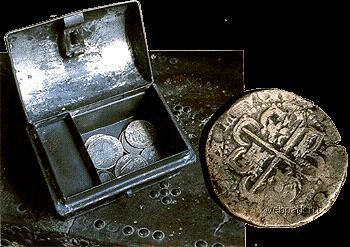
Coconut Island, located at 5 ° 33 'N and 2 ° 87 'W, has long been known as "Treasure Island", "pirate safe" and "Mecca of hunters." For the past half century, this tiny, covered with impenetrable jungle piece of land (length of 6, 5 km, a width of 3, 2 kilometers) attracted the attention of many hunters. It is estimated that for the whole time it was visited by more than 500 expeditions, whose members have invested in the search for treasures fortunes. Here, hundreds of people were killed, but the treasure was never found ...
More recently, in the summer of 1962, landed on the island of Coco-French group of hunters: caver Robert Verne, journalist Jean Portelli and writer Claude Charlier. They are widely advertised its plans searches pirate gold, hoping, even if the treasure is not, then the fees for the adventures of the printed book, TV and radio programs will exceed expenditures. But fate decided otherwise ... At that moment, when they examined the grotto overlooking the sea in the Bay of Chatham, the engine suddenly stalled, and paddle boats lay at the bottom, crushed by a tent. The sea was choppy and ran up the side of a wave overturned the boat ... I'll be washed up on the rocks, and two of his friends did not let the sea ... Only two months later, happened to be passing ship Verne withdrew from the island.
Not for nothing in a book about the treasure hunt has been said:
"Over the treasures it gravitates like a curse that kills the soul and the body. It is, of course, has nothing to do with the curse that pirates allegedly uttered over his treasures:
"Let him who touches my gold hidden here, remember that the way back was not long knife blade & quot ;. The curse of greed - that is what hangs over the treasure. Curse that kills ... & quot;
It is believed that the island holds in its bosom wealth of the three famous pirates: William Dampier, Alexander Graham and Scott Thompson. The history of the treasure, which is associated with the names of the last two Pirates.
In the autumn of 1820 forces the liberator of Argentina, Chile and Peru - General Jose San Martin stepped on the Spanish colonizers from the south. Peru's capital was cut off from the north of the Spanish possessions troops of Simon Bolivar. The Viceroy of Peru Joaquin Pesuela decided to forward the state of wealth in Panama. The treasures looted by the Spaniards during the years of dominion, were secretly delivered to the port of Callao. Modern assessment of the Peruvian treasury fluctuates within the following limits: 10 million pesos according to the Spaniards, 30 million pounds on the British and US $ 30 million for the American version. In Callao were five ships. In the hold of one of the galleons - "Relampaga" - secretly loaded value.
At the entrance to the Gulf of Panama "golden" squadron blocked the road pirate brig Graham, named Benito Bonito ...
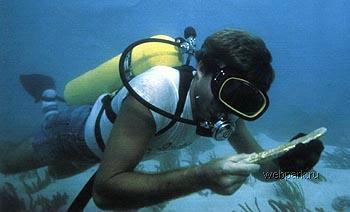
Graham, like Dampier, he served in the Royal Navy. As commander of the brig "Devonshire", he distinguished himself in the Battle of Trafalgar. With the death of Nelson's glory to the heroes of Trafalgar was the ebb and Graham left the service. He became Benito Bonito, crime earned him another nickname - Bloody Sword (or sword: looking how to translate from English word sword).
Corsairs Benito Bonito boarding battle captured galleon "Relampaga." And it turned out to hold in his Lima treasure! The pirates took the ship to the island of Cocos. There, on the shore of the bay Ueyfer in an underground cave, Benito Bonito hid the barrels and treasure chest ... Soon two English brigs overtook pirate ship off the coast of Costa Rica. Alexander Graham was hanged from the yardarm, and took with him the secret of the treasure.
The second legend of the treasure of Lima claims that it was sent from Callao on the pirate ship Scott Thompson "Mary Dieren." Corsair Spaniards promised great rewards, loaded into the hold of his brig "important public documents" and put their guard down. But it was difficult to hold Thompson. Pirates broke the Spanish guards, and looked into the hold ... and cut off the anchor line, treacherous brig dashed into the open ocean. But behind him rushed warship. He caught up with the ship Thompson, however, only in the Bay Ueyfer Cocos Island.
Because the treasure in the hold is not turned, the Spaniards hung all but Thompson and his chief navigator. They were taken to a prison in Panama, hoping to gain recognition. But on the way the navigator died, and the captain kept the secret treasure, knowing that only so can save lives.
The wave of the liberation struggle in 1821 has come to Panama. She released the will of the Spanish prison inmates, among whom was and Scott Thompson. He moved to Canada, lived for many years in Newfoundland, collecting money for the expedition to Cocos Island. Thompson signed an agreement with Captain Keating, but in front of the swimming seriously ill and dying, gave Keating map of the island with the scheme of the treasure.
Keating expedition reached the island. The captain and his new companion Baugh tried to hide from the team Coco purpose of the visit. Under the pretext of hunting the two of them went ashore, and this aroused the suspicions of the team. The sailors searched in their absence the captain's cabin, found a bag of jewels. There was an explanation, the team demanded the division. Keating and Baugh for the kind of agreed, and left the ship at night and hid in a cave. Mariners could not find them on the island, and they left without a captain. After some time, a random whaler picked up on the shore of the island exhausted man. It was the captain of Keating. He said that his team, raising a rebellion, seized the brig, and it landed. About Bogey Keating did not mention. It is believed that he killed Baugh in a cave in the division of treasure. With whalers he returned to Newfoundland. The remains of clothes, he kept a handful of precious stones. Before his death, he handed the card Thompson some friend, and then she became the public domain. Now everyone can buy it, and along with a few dozen cards from the "Atlas of treasures", published in New York in 1952 ...
According to legend, a small island Amalia famous pirate Edward Teach, known as "Blackbeard" repaired their ships and bury its treasures.
How to tell the chronicle looted treasures Thich carried away into the interior of the island with one of the sailors did not like him. Teach carried two saddle bags with jewels, and a sailor - a box with a gold and a shovel. The captain chose a suitable place, and while the sailor was digging a hole, sat nearby and smoked a pipe. Once the sailor got out of the pit, he shot him in the head and down treasures, face to the body and a sailor. When asked after his return, where the sailor, then Thich usually answered that he either "stuck in a swamp," or "escaped into the sea from cliffs." Teach was killed in November 1718, and took with him to the grave the secret treasures.
After Edward Teach Amelia Island became the base of the French pirates brothers Jean and Pierre Lafitte. They were engaged in the "expropriation of the expropriators" - robbed the Caribbean slave traders. Selling captured Negro slaves, they hid on the island of "earned" money.
Officially, it is known that in 1809 the ship was caught Jean Lafitte British frigate off the northern coast of the Gulf of Mexico at a time when the pirates were going to unload on shore looted treasures. Realizing the hopelessness of the situation, the captain of his ship sunk.
Since the coordinates of the flooded ships were precisely known, in 1949 the American company «Kirger and Been Exploration Company» start development works. But despite the use of the latest technology at that time, the search is not successful, obviously, the ship's hull is deeply sucked into the bottom mud.
Apart from Ticha and Lafitte, the island served as a refuge is still very much a band of pirates, so modern treasure hunters constantly visit the island, and with enviable persistence doomed, looking for treasures using metal detectors and other devices.
However, there are also good luck: in 1939 American expedition found on Mona Island, located in the Caribbean Sea between Haiti and Puerto Rico, the treasure hidden English pirate William Jennings. On sale at an auction in Chicago found gold coins and jewels was to gain about a million dollars. It is worth to say that today the cost is often much higher than the same coin denomination. And not because the price of gold rose, but because the coin is of interest already as a rarity for collectors.
Among the historical incidents related deaths in 1600 Spanish galleon "San Diego". This ship laden with riches went to sea at the whim of a Spanish official to attack seen near Manila battered by storms Dutch sailboat corsair. Because of incompetent commanders chetyrnadtsatipushechnoe huge ship (at the time it was a very solid weapons for the ship) was sunk at the entrance to Manila Bay. Several years ago, the goods with the "San Diego" raised from the bottom of the French archaeologist Franck Goddio submarine.
Not only the wealth of the Aztecs and the Incas, but also tons of other goods from Southeast Asia, carried in the holds of ships. Sometimes the value of these goods in the European markets was equal, and sometimes superior to gold. For two and a half centuries came from the Philippines to Europe "Manila Galleon". In 1638 near the island of Saipan wrecked ship "Nuestra Senora de la Concepcion", carrying porcelain, ivory and gold. After 350 years, an international team of treasure hunters pulled from the bottom of a large part of these treasures.
Link to source
If the map of the Western Hemisphere by the City of Montreal to the southeast draw a straight line to the Cape of Cabo Frio, located at the eastern tip of South America, and then connect the line this cape to Cocos Island in the Pacific Ocean near Panama, and spend another line from Coco to Montreal, the triangle will appear on the map. Throughout the world, it is called the "Golden Triangle" or "Triangle of treasure." Whose treasure here looking for?

centuries in the southern seas were the battle for the gold of America and India. As a result of the treasures they settled not only in the execution of the king.
At the beginning of the XVI century from America to Europe flooded gold. Wealth Aztecs and Incas, filled the holds of Spanish galleons, in just one century increased the gold and silver reserve of European countries five times.

At first, ships bound for Spain, went across the Atlantic in small groups without an armed escort. But soon loomed on the horizon threatening competitors. Already in 1496, Christopher Columbus, returning from his second voyage, was attacked by French corsairs. However, the main threat to the Spanish fleet of galleons were English privateers - pirates in the service of the British Crown. Many of them, such as the famous navigator and pirate Francis Drake, was given the title of nobility - for deeds of his fatherland brought millions of pounds of gold. It was a "legitimate" part of the production is supplied to the royal treasury after successful privateers attacks on Spanish ships.
Drake became famous for his daring raids on Spanish ports in South America and in Spain itself. However, most of the privateers serve more cautious approach: they lay in wait for returns from America Spanish ships in the Caribbean or in the Azores.
Azores in the XVI century were the main transshipment point in the global trade routes. Wherever came the ships - from America, India or South Africa, their path lay through the abandoned in the vastness of the Atlantic island of Terceira, Pico and Jorge. There stocked with food and drinking water. Azores called "hotel, which the Lord has put in place a suitable ocean."
In the waters around this "hotel" buried dozens of ships. In 1594 a Portuguese ship "Chagas' returns from the Indian colonies. According to testimonies and archival documents, it was the price of the treasure in the then two million ducats - gold coins, each weighing 3, 5 grams. It was the most expensive load ever goes to Europe from India. Also on board were two sailors shipwrecked Portuguese schooners. Swimming turned out awful even by the standards of a cruel time: due to the excessive number of crew on board played out several epidemic diseases, but the worst was the scurvy. Hourly had to dump overboard dead. This "floating hospital" was an easy catch for the three English ships that ambushed near one of the Portuguese Azores. After a very brief exchange of fire in the gun gunpowder hold of the ship fire broke out and the ship sank in the Atlantic Ocean. Until now find his remains no one has. Also irretrievably sunk close to the Azores in 1591, the Spanish "Silver Fleet» (Silver Train) - ships have been a victim of the famous "Plotnitsky wind." This insidious southeast hurricane is so named because it often brings to the shore wooden wreckage wrecked ships.

According to historical sources, in the region of only one bay of Angra near the island of Terceira has sunk at least 88 ships. But look here - it's like trying to find a needle in a haystack. When the summer of 1997 the Portuguese-American expedition began to explore the bay with modern equipment, scientists depressed. Day after day, on board his ship, they sounded out the bottom of the special sonar that could explore the deposits to a depth of five meters. But make sure only that hidden sand cliffs distorts any signal. Reactive metal magnetometers that can catch the slightest changes in the magnetic field, are here completely helpless. Not gold bars, coins, anchors or cannons, and iron-containing volcanic rock made underwater compasses spinning arrows. "Search is a metal such devices - the same as in a disco to listen through headphones Mozart" - says archaeologist Paulo Monteiro.
Only in the waters of the harbor, the researchers were lucky with the findings. Under the layer of sediments and the mountains of ballast stones, they discovered the remains of four timber ships. Fragments of the oldest of them, lying at a depth of seven meters, are roughly to 1500 - a time when the Azores were just discovered by Spanish explorers. Now archaeologists have examined in detail the oldest ship found here remains anticipating the moment when the open under the rubble "gold mine." However, it is possible that part of the resources raised from the bottom of the sailors themselves, the survivors from sunken ships. With the help of diving bells and ventilation hoses they could go down to a depth of ten to twenty meters.
Already in the XVII century it was the first hunters drowned in gold. In 1686, Englishman William Phipps raised from the bottom of the Caribbean Sea of gold and silver on the equivalent of one and a half million US dollars. It was only a small part of the treasure of the Spanish galleon 16 "Golden Fleet» (Golden Fleet), sunk during a storm in 1643 in the shallows of the Silver Banks north of Haiti. Here, in the Bahamas, Haiti (formerly Hispaniola) and the Straits of Florida, the Spanish treasury was lost for three centuries fabulous wealth. The idea of their size can give a "catch" that the day brought the American Herbert Humphrey, stumbled on the galleon "Nuestra Senora de las Maravillas" - 177 silver bars, gold bars polukilogrammovyh 15 and 10 gold nuggets.
The base of the pirates in the Caribbean has long been the Isle of Pines (now called Isla de la Juventud and belongs to Cuba). According to legend, there were hidden treasures Drake, pirate Lafitte and other celebrities. There were fake card, which warmed the hands nimble adventurers. In our century treasure hunters come here constantly, but luck is only one of them - in the fifties American Uikker found at the underwater reef chest of gold and jewels. Another well-known pirate place - owned Costa Rica Cocos Island in the Pacific Ocean, north of the Galapagos Islands. According to historical records of sea robbery, the first treasure hidden here that the famous pirate Henry Morgan, who was such a good standing with the British authorities that ended his days as governor of Jamaica. The number of hunters who visited the coconut, close to a hundred. However, none of them have not yet managed to find any treasure Morgan nor treasures of Lima, collected by the Spaniards during the rule in Peru and captured the port of Callao English Captain Thompson.

Coconut Island, located at 5 ° 33 'N and 2 ° 87 'W, has long been known as "Treasure Island", "pirate safe" and "Mecca of hunters." For the past half century, this tiny, covered with impenetrable jungle piece of land (length of 6, 5 km, a width of 3, 2 kilometers) attracted the attention of many hunters. It is estimated that for the whole time it was visited by more than 500 expeditions, whose members have invested in the search for treasures fortunes. Here, hundreds of people were killed, but the treasure was never found ...
More recently, in the summer of 1962, landed on the island of Coco-French group of hunters: caver Robert Verne, journalist Jean Portelli and writer Claude Charlier. They are widely advertised its plans searches pirate gold, hoping, even if the treasure is not, then the fees for the adventures of the printed book, TV and radio programs will exceed expenditures. But fate decided otherwise ... At that moment, when they examined the grotto overlooking the sea in the Bay of Chatham, the engine suddenly stalled, and paddle boats lay at the bottom, crushed by a tent. The sea was choppy and ran up the side of a wave overturned the boat ... I'll be washed up on the rocks, and two of his friends did not let the sea ... Only two months later, happened to be passing ship Verne withdrew from the island.
Not for nothing in a book about the treasure hunt has been said:
"Over the treasures it gravitates like a curse that kills the soul and the body. It is, of course, has nothing to do with the curse that pirates allegedly uttered over his treasures:
"Let him who touches my gold hidden here, remember that the way back was not long knife blade & quot ;. The curse of greed - that is what hangs over the treasure. Curse that kills ... & quot;
It is believed that the island holds in its bosom wealth of the three famous pirates: William Dampier, Alexander Graham and Scott Thompson. The history of the treasure, which is associated with the names of the last two Pirates.
In the autumn of 1820 forces the liberator of Argentina, Chile and Peru - General Jose San Martin stepped on the Spanish colonizers from the south. Peru's capital was cut off from the north of the Spanish possessions troops of Simon Bolivar. The Viceroy of Peru Joaquin Pesuela decided to forward the state of wealth in Panama. The treasures looted by the Spaniards during the years of dominion, were secretly delivered to the port of Callao. Modern assessment of the Peruvian treasury fluctuates within the following limits: 10 million pesos according to the Spaniards, 30 million pounds on the British and US $ 30 million for the American version. In Callao were five ships. In the hold of one of the galleons - "Relampaga" - secretly loaded value.
At the entrance to the Gulf of Panama "golden" squadron blocked the road pirate brig Graham, named Benito Bonito ...

Graham, like Dampier, he served in the Royal Navy. As commander of the brig "Devonshire", he distinguished himself in the Battle of Trafalgar. With the death of Nelson's glory to the heroes of Trafalgar was the ebb and Graham left the service. He became Benito Bonito, crime earned him another nickname - Bloody Sword (or sword: looking how to translate from English word sword).
Corsairs Benito Bonito boarding battle captured galleon "Relampaga." And it turned out to hold in his Lima treasure! The pirates took the ship to the island of Cocos. There, on the shore of the bay Ueyfer in an underground cave, Benito Bonito hid the barrels and treasure chest ... Soon two English brigs overtook pirate ship off the coast of Costa Rica. Alexander Graham was hanged from the yardarm, and took with him the secret of the treasure.
The second legend of the treasure of Lima claims that it was sent from Callao on the pirate ship Scott Thompson "Mary Dieren." Corsair Spaniards promised great rewards, loaded into the hold of his brig "important public documents" and put their guard down. But it was difficult to hold Thompson. Pirates broke the Spanish guards, and looked into the hold ... and cut off the anchor line, treacherous brig dashed into the open ocean. But behind him rushed warship. He caught up with the ship Thompson, however, only in the Bay Ueyfer Cocos Island.
Because the treasure in the hold is not turned, the Spaniards hung all but Thompson and his chief navigator. They were taken to a prison in Panama, hoping to gain recognition. But on the way the navigator died, and the captain kept the secret treasure, knowing that only so can save lives.
The wave of the liberation struggle in 1821 has come to Panama. She released the will of the Spanish prison inmates, among whom was and Scott Thompson. He moved to Canada, lived for many years in Newfoundland, collecting money for the expedition to Cocos Island. Thompson signed an agreement with Captain Keating, but in front of the swimming seriously ill and dying, gave Keating map of the island with the scheme of the treasure.
Keating expedition reached the island. The captain and his new companion Baugh tried to hide from the team Coco purpose of the visit. Under the pretext of hunting the two of them went ashore, and this aroused the suspicions of the team. The sailors searched in their absence the captain's cabin, found a bag of jewels. There was an explanation, the team demanded the division. Keating and Baugh for the kind of agreed, and left the ship at night and hid in a cave. Mariners could not find them on the island, and they left without a captain. After some time, a random whaler picked up on the shore of the island exhausted man. It was the captain of Keating. He said that his team, raising a rebellion, seized the brig, and it landed. About Bogey Keating did not mention. It is believed that he killed Baugh in a cave in the division of treasure. With whalers he returned to Newfoundland. The remains of clothes, he kept a handful of precious stones. Before his death, he handed the card Thompson some friend, and then she became the public domain. Now everyone can buy it, and along with a few dozen cards from the "Atlas of treasures", published in New York in 1952 ...
According to legend, a small island Amalia famous pirate Edward Teach, known as "Blackbeard" repaired their ships and bury its treasures.
How to tell the chronicle looted treasures Thich carried away into the interior of the island with one of the sailors did not like him. Teach carried two saddle bags with jewels, and a sailor - a box with a gold and a shovel. The captain chose a suitable place, and while the sailor was digging a hole, sat nearby and smoked a pipe. Once the sailor got out of the pit, he shot him in the head and down treasures, face to the body and a sailor. When asked after his return, where the sailor, then Thich usually answered that he either "stuck in a swamp," or "escaped into the sea from cliffs." Teach was killed in November 1718, and took with him to the grave the secret treasures.
After Edward Teach Amelia Island became the base of the French pirates brothers Jean and Pierre Lafitte. They were engaged in the "expropriation of the expropriators" - robbed the Caribbean slave traders. Selling captured Negro slaves, they hid on the island of "earned" money.
Officially, it is known that in 1809 the ship was caught Jean Lafitte British frigate off the northern coast of the Gulf of Mexico at a time when the pirates were going to unload on shore looted treasures. Realizing the hopelessness of the situation, the captain of his ship sunk.
Since the coordinates of the flooded ships were precisely known, in 1949 the American company «Kirger and Been Exploration Company» start development works. But despite the use of the latest technology at that time, the search is not successful, obviously, the ship's hull is deeply sucked into the bottom mud.
Apart from Ticha and Lafitte, the island served as a refuge is still very much a band of pirates, so modern treasure hunters constantly visit the island, and with enviable persistence doomed, looking for treasures using metal detectors and other devices.
However, there are also good luck: in 1939 American expedition found on Mona Island, located in the Caribbean Sea between Haiti and Puerto Rico, the treasure hidden English pirate William Jennings. On sale at an auction in Chicago found gold coins and jewels was to gain about a million dollars. It is worth to say that today the cost is often much higher than the same coin denomination. And not because the price of gold rose, but because the coin is of interest already as a rarity for collectors.
Among the historical incidents related deaths in 1600 Spanish galleon "San Diego". This ship laden with riches went to sea at the whim of a Spanish official to attack seen near Manila battered by storms Dutch sailboat corsair. Because of incompetent commanders chetyrnadtsatipushechnoe huge ship (at the time it was a very solid weapons for the ship) was sunk at the entrance to Manila Bay. Several years ago, the goods with the "San Diego" raised from the bottom of the French archaeologist Franck Goddio submarine.
Not only the wealth of the Aztecs and the Incas, but also tons of other goods from Southeast Asia, carried in the holds of ships. Sometimes the value of these goods in the European markets was equal, and sometimes superior to gold. For two and a half centuries came from the Philippines to Europe "Manila Galleon". In 1638 near the island of Saipan wrecked ship "Nuestra Senora de la Concepcion", carrying porcelain, ivory and gold. After 350 years, an international team of treasure hunters pulled from the bottom of a large part of these treasures.
Link to source
